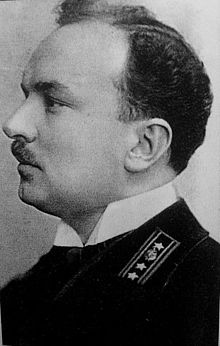Eižens Laube
| Eižens Laube | |
|---|---|

Eižens Laube around 1913.
|
|
| Born |
May 25, 1880 Riga, Russian Empire |
| Died | July 21, 1967 Portland, Oregon, U.S. |
| Nationality | Latvian |
| Education | Riga Polytechnic Institute |
| Known for | architecture |
| Movement | Art Nouveau |
| Awards |
Order of Three Stars Cross of Recognition |
Eižens Laube (May 25, 1880 – July 21, 1967) was a Latvian architect. He was responsible for some of the reconstruction work of Riga Castle in the 1930s and designed more than 200 houses in Riga.
Eižens Laube was born in Riga as a son of a potter. In 1899 he graduated Realschule and started architecture studies in Riga Polytechnic Institute. While still a student he started to work in Konstantīns Pēkšēns's architecture office in 1900. In 1904 he took a study trip to Finland where he was introduced to National Romanticism in architecture. Laube graduated from the Riga Polytechnic Institute's department of architecture in 1907. Soon after he established his own architectural office in Riga. He also became lecturer in Riga Polytechnic Institute. In 1909 he traveled to Sweden and Germany to improve his professional abilities. In 1910 he took identical trip to France. From 1909 to 1914 he was the official adviser to the Commission for Artistic Issues in Architecture, in Riga.
After the First World War started in 1915 Laube together with Riga Polytechnic Institute was evacuated to Moscow. He returned to Riga in 1917. In 1919 he became one of the founding members of University of Latvia and became dean of Faculty of Architecture. He was elected professor in 1920. In 1922 he briefly became rector of the university. He was also chairman of the Latvian Architects Society (1924–26). In the 1930s he again became dean of Faculty of Architecture. In 1938 he participated in establishment of first Latvian professional architectural magazine Latvijas Architektūra.
After the Occupation of Latvia in 1940 he was dismissed from all posts but was not physically repressed. After the Occupation of Latvia by Nazi Germany Laube resumed his work in the University in the autumn 1941. In 1944 he emigrated to Germany where he worked as a professor of architecture at the Baltic University, Pinneberg, near Hamburg. From 1950 he lived in Olympia, Washington in the United States where he worked in an architecture office. Since 1955 he lived in Portland. He devoted his last years to writing and died in July 21, 1967, in Portland.
...
Wikipedia
